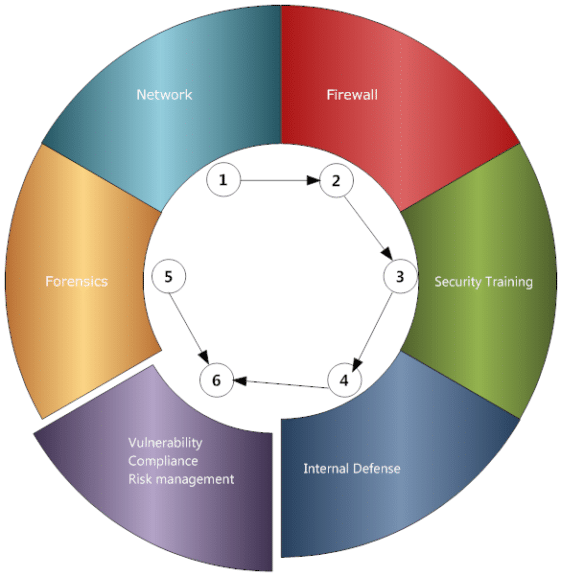The network vulnerabilities also vary based on organization and in terms of complexity and severity. Therefore, it is crucial to understand vulnerabilities to review security policies, draft protocols, and implement best practices to prevent network vulnerability.
What is Network Security?
The network generally consists of policies, processes, and best practices to adopt to prevent, detect and monitor unauthorized entry to misuse the network resources. Network security is an activity designed to protect the integrity and usability of the network and its data. It combines multiple layers of security at the edges and within the entire network.
Network Vulnerabilities:
Network vulnerability is a flaw, loophole, or weakness in the system software, firmware, organizational process, or hardware that can hamper the normal functioning of the network. When it is compromised by intimidation can result in a security breach. It can be either physical or non-physical. Physical: hardware components of your system. Non-physical is the flaw in software or fault in any organizational process.
Usually, the vulnerabilities put the business and the sensitive data at risk. It may lead to easy targets to hackers, loss of reputation, and penalties. If any of the entities of your network, namely hardware, software, and organizational process, are not properly managed, then the networks will be an easy target for vulnerable people.
Hackers exploit the cyber or network vulnerabilities to attempt to steal data, launch DDoS attacks and phishing attacks, and infect network systems with Malware, Viruses, Trojans, Worms, ransomware, or any other type of attack.
Physical Vulnerability:
This kind of vulnerability involves the physical protection of the entire physical network and server and securing entry points of the network. Servers should have the most robust physical security controls, such as a strong room with restricted access, with high-security code access to the physical entry to the server. In addition, most of the servers store voluble data such as trade secrets, formulas, plans to execute, consumer data, and others. Therefore they need more physical security controls such as biometric scanners and other high-tech access control to eliminate the risk of unauthorized user access.
Non-Physical Vulnerability:
It involves the data and software. Cyber attackers can compromise the operating system if they are not updated with the latest updates, security patches, or firmware updates. If they are vulnerable, the virus or malware could infect the Operating System and thereby potentially infect the entire system.
A good firewall can protect the network against blacklisted IPs and avoid DDOS attacks. Now a day’s, most administrators use web application firewalls instead of traditional firewalls, which can identify attack patterns and block such requests. Web application firewalls are the next-generation firewalls. And they can guard against SQL injections, cross-site scripting, and other attacks.
One firewall protection is not enough. All ways keep away the sensitive data away from the network edge. Always keep them with a secondary firewall further to minimize exploitation.
Different Types of Most Common Vulnerabilities:
There are various Network vulnerabilities the hacker can exploit to gain access to the network system and get crucial data.
Here are the few most common types:
- Malware
- Outdated Software
- Misconfigured Operating Systems or Firewalls
- Social Engineering Attacks
Malware:
The hacker con infiltrates the network devices or the server with worms, Trojan horses, viruses, rootkits, adware, spyware, ransomware, and other malicious software. The infected network devices may run slower, send unsolicited emails, randomly reboot or independently start an unknown process.
Outdated Software:
To minimize vulnerabilities, software developers constantly come out with new software updates and patches to fix bugs, errors, or feature upgrades. Therefore the developers need to deploy patches to check the vulnerabilities. The server running an application without adequate patches can potentially harm and infect the entire network if the hacker finds and manipulate the flaw.
Misconfigured Operating System or Firewalls:
The most worrying threat is exposing your network server to the internet; if exposed, criminals can easily penetrate your network and compromise it. Therefore firewalls are deployed between your server and the internet. The Firewall acts as a buffer and monitors the inbound and outbound data and further allows or blocks the traffic based on the set of rules assigned. The network administrators create rules for incoming and outgoing network communication. Firewall is sometimes set up in front of the web server and configured to specific needs and to block such as internet control message protocol and a ping request.
Most of the Operating System policies with default settings and security precautions should be revived according to your network specification and needs to protect your network.
Social Engineering Attacks:
Network intruders can easily fool the user into leaking confidential data. In addition, social engineering attackers can easily bypass the authentication and authorization security protocol and gain access to the network easily.
These types of vulnerability are increasing significantly over the last few years.
Most internet users are unaware of the threat posed by hackers. Here are a few common types of social engineering attacks:
- Phishing
- Spear phishing
- Vishing
- Smishing
- Tailgating
- Pharming
- Whaling
- Dumpster Diving
- Shoulder surfing
- Spam
- SQL Injections
- DDOS
- Cross-site scripting
- Buffer Overflow
Broadcast Level Network Vulnerabilities:
Though penetrating testing is carried out to guard against network vulnerabilities, new kinds of cyber attacks keep emerging. First, let us focus on broadcast-level network vulnerabilities. They fall into three categories, namely hardware-based, software-based, and human-based.
Hardware-Based Vulnerabilities:
The network devices, which are not properly managed, will pose a security threat. The router and other security appliances are the first lines of defense and should be managed appropriately to work. The firmware is upgraded and patched periodically. They should be replaced as and when needed. One of the easiest ways to break through the network is to gain physical access to unsupervised devices.
The intruded can easily hack the device and install any malware, key loggers, or spyware. The handheld devices such as Smartphones, laptops, or tablets can be easily stolen or compromised, and the hacker can easily get inside the network. Therefore the handheld devices which regularly leave the office should be properly encrypted and protected with a strong password.
Most Internet of Things devices has inadequately secured. Using such devices will become vulnerable nodes in the network. Therefore, buying IoT devices with the best firmware and appropriately configured by a reputable seller is crucial. If you suspect any of the IoT devices in the network, segregate them into a subnet that has restricted access to the network. Sometimes the employees connect unauthorized devices to do their job.
They might have lesser security standards. Therefore the network administrator needs to stipulate BYOD policies and set the standard for acceptable devices, including the software. And strictly enforce them to protect their own network. In addition, the administrator should vet the entire unauthorized device or the user-owned devices. Those devices must have limited access or a limited role in networking. Besides, the network administrator should keep the inventory of all connected devices and their IPs so that they can track the intruder in the event of any threat.
Software-Based Vulnerabilities:
We have discussed software-based vulnerabilities in the first part of the post. Let us discuss others not else covered earlier. The usage of the application must not be wide open, and its use must be limited to avoid easy exploitation of flaws in the network. The outdated software has its own vulnerabilities. Therefore periodic network vulnerability scanning should be undertaken to discover the flaws in the network.
Special care should be taken on Plug-ins and add-ons while network scanning since they are the easy target in the content management system. Some software based on in-house code written may have unknown flaws, which are easy targets for zero-day exploitation. Proper access control can limit the danger considerably. When the user employs unapproved software or hardware on their system without going through the proper approval can create a security threat. Therefore policy should be enforced strictly.
Most Operating Systems, applications, and software defaults are generally optimized for usability than security. Therefore proper care should be taken to configure the software properly to protect against security breaches. Safeguarding all the administrative accounts and restricting access to them will keep the network safe. Though using VPN may be valuable, the virtual private network has its own security risks; therefore, an appropriate configuration of the same is essential.
Though, you can connect your devices to the internet using Wi-Fi easily. But this can be vulnerable. Some Wi-Fi networks set up access points without any password. A poorly secured Wi-Fi can allow other devices to connect and get past the Firewall. Therefore Wi-Fi access points with default configuration must enable the use of SSID and password. Besides, the Wi-Fi routers should have different SSID and passwords.
User-Based or Human-Based Vulnerabilities:
A network’s hardware and software components can be managed effectively, but the users can make mistakes. For example, they may use weak passwords, or they do not keep them safe. Sometimes they may open phishing or malicious links and thereby expose the network vulnerable.
Therefore they should be educated and appropriately trained. Generally, people are not good at generating strong passwords; therefore, the user should be encouraged to use a good password manager or to use multi-factor authentication to improve account security and avoid password theft. Else impose minimum password complexity requirements using the appropriate software. Proper security awareness, testing, and training should be done.
Network Vulnerability Assessment:
Vulnerability assessment is a process that assists an organization in exploring, analyzing, and evaluating the security concerns in the network system. In other words, Vulnerability assessment is the process of identifying and quantifying security vulnerabilities within a network environment.
The assessment will find the flaws and vulnerabilities in the internal and external network system. Network vulnerability assessment is to identify and resolve the security issues within a network.
Do not forget to install Intrusion Prevention System or Intrusion Detection System (IPS or IDS) to monitor your network for any policy violation or malicious activity. They function as next-generation firewall protection and offer an additional layer of protection.
The network administrator must back up the data periodically to protect the business from any data loss due to any security breach.
The network must be segmented so that the external network cannot access the internal network. If possible, employ a Network Address Translation (NAT) to translate internal IP addresses into addresses accessible on public networks. NAT can be used to connect multiple systems to the internet using the same IP.
Conclusion:
The administrator and the users must know about the network vulnerabilities. They must be aware every person, every piece of hardware and every software can pose a security threat to the network, and the security policies should be periodically reviewed and enforced to protect the network against network vulnerabilities.







